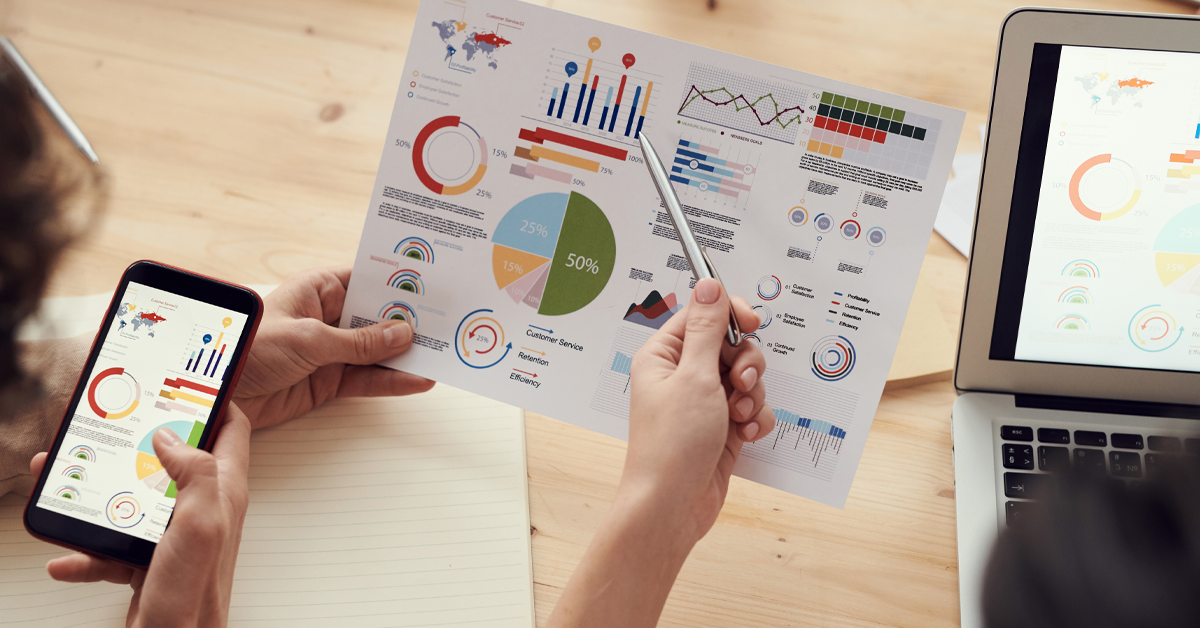Datasets have become complex, fast-moving and increasingly huge.
Traditional BI systems are overwhelmed with the increasing volume of data.
Automation of data management in today’s day and age looks like the next logical step.
Not only does it automate data management, it also simplifies the task of data scientists.
Coined by Gartner, “augmented analytics” is the future of BI that interacts with data as humans would but on a much larger scale to cater to the big data needs.
The goal of augmented analytics is to automate the process of data collection and data preparation so as to save 80% of data scientist’s time.
However, ultimately augmented analytics will completely replace the manual work of the data science teams with AI.
Augmented Analytics takes care of the entire analysis process from data collection to presenting business recommendations for decision-makers.
This brings us to the question, what exactly is augmented analytics.
Table of Contents
What is augmented analytics?

Augmented analytics is a new way to look at data and analytics.
It’s the combination of analytics and AI.
It includes embedding artificial intelligence (AI), in the form of machine learning (ML) and natural language processing (NLP), into traditional analytics.
It’s different from traditional business intelligence (BI) tools because ML technologies are always working behind the scenes to continuously learn and enhance results.
Augmented analytics enables faster access to insights to provide ML-based recommendations.
This intelligence helps identify hidden patterns, deviations in data, removes human bias and enables predictive analytics to inform an organization of what to do next.
Evolution of business intelligence

From monitoring performance and KPI analysis to being sophisticated analytics powered by Artificial Intelligence. BI tools have evolved over time.
Traditional BI
Traditional BI was the first of its kind that organizations could use to make better decisions based on their data.
This stage of BI focused primarily on connecting to single databases and generating basic reports.
The analysis was unsophisticated and not very timely.
There was room for improvement and it came in the form of the next generation of analytics and BI: self-service BI.
Self-Service BI
Since traditional BI needed highly skilled technical workers, lengthy times-to-insights, and poor quality of data being analyzed, self-service BI aimed to address these.
With self-service BI, users are often able to get to the answers they want without calling IT for help or learning advanced database language skills.
Even non-technical users can manipulate data sources and get them ready for analysis, speeding up time to insights and helping eliminate IT bottleneck.
In fact, modern BI solutions make data governance, security and access control simpler for IT teams.
Yet these enhancements aren’t enough. We need to approach data differently.
4 reasons to think of data and analytics differently

There are still areas where we need to think about data and analytics differently.
- Data preparation could be simplified, new ways of countering user bias need to be developed and the business-led aspects of the industry have to be countered. We need to think about data itself in a whole new way.
- While modern BI solutions can handle more types of data and a greater volume, cleaning up that data is still a manual process. This brings in the possibility of human error before the analysis has begun.
- Modern BI tools are great at showing insights. The problem is, that’s all they do. If a user knows exactly what they’re looking for, chances are they’re going to find it. This leaves very little room for surprising and unexpected results that the user might not have been thinking of, which are exactly the kind that can have a massive impact on an organization.
- Data comes from countless sources. It can be a huge challenge for IT departments to connect these disparate data sources and get them into an analytical platform.
The old way of doing BI doesn’t work for the new world. So, what should the future of analytics and BI look like?
Top 4 reasons to adopt augmented analytics

Data access has to be democratized, with stakeholders from across the company to access intelligent, self-service solutions and find the answers that matter most to them as well as perform surprising and game-changing analyses.
Let’s consider the top four reasons why organizations are adopting augmented analytics to deal with the growing volume of unstructured and structured data.
1. Democratization of data
Augmented analytics enables data to be available to everyone. These come prebuilt with models and algorithms so that there is no dependency on IT. These models come with user-friendly interfaces so that business users and executives can easily use them
2. Faster decision-making
Augmented analytics will recommend which datasets to include in analyses, alert users when datasets are updated and suggest new datasets if users are not getting the results expected. All users receive accurate forecasts and predictions based on historical data in just one click.
3. Automated recommendations
NLP in Augmented analytics allows non-technical users to easily ask questions from source data. Natural language generation (NLG) then automates the process of translating complex data into text with intelligent recommendations, thereby accelerating analytic insights. By using automated recommendations for data enrichment and visualization, anyone can quickly uncover unseen patterns and predict trends. NLP also helps drive the ability for non-expert users to make sense of large amounts of data.
4. Become a true data-driven company
The importance of understanding data is more critical than ever. In the era of big data, analytics has become vital to doing business – from understanding sales trends, to segmenting customers based on their online behaviors and predicting how much inventory to hold. Data is a notable asset, yet analytics is what makes data valuable in the end.
How augmented analytics is delivering maximum value?

This new paradigm is different because its subtle integration of artificial intelligence and natural language processing elements changes the user experience.
- Intelligent augmented analytics simplifies data ingestion. Instead of having humans clean up data, fit together data sources and choose which datasets to mashup for their analysis, AI components will do much of the heavy lifting. Going smoothly from data ingestion to searching for insights will be a huge time saver from even streamlined modern BI systems.
- Augmented analytics will understand the differences between the datasets, how they interact with each other and how best to query them for the fastest results. Instead of being passive receivers and holders of data, these smart analytics tools will be active in interweaving the data as it comes in and assisting in analysis.
- People usually look for the things they want to find and only end up finding what they are looking for. The AI in augmented analytics platforms will be free of human biases and will reveal insights that the humans never realized they needed.
- Understanding insights will also change under augmented analytics. Natural Language Processing (NLP) gives BI a voice. When new data is pulled into the system, the NLP components will be able to read and understand more of the data and draw conclusions from it. It will then surface those new discoveries to the human user in a conversational manner. Humans will be able to query just by saying “show me my sales numbers for the last year” or asking “what was our revenue change over the last six months?”
- Analytics and BI will become immersive. New insights and data will be accessible via a wide range of devices just by asking a question from a chatbot or voice interface.
- Intelligent assistants will notify decision-makers when something needs their attention, instead of waiting to be asked. In many situations to get instant updates when changes are happening and then reacting in real-time.
Importance of having correct insights

Augmented analytics platform takes people from questions to insights to decisions within a persistent environment, across departments, teams, devices and locations.
Non-technical users or teams that do not perform analysis frequently but could still benefit from the right insight at the right time.
Some systems even allow users to embed actions like launching a marketing campaign right alongside the insights.
Embedding could also empower a client’s software with analytical capabilities without them having to build the new functionality from scratch, serving internal teams and surfacing insights to end-users/customers as well.
This all contributes to the overall feeling of an immersive, always-on environment, constantly serving up insights and improving users’ lives with data.
Data cognition

Augmenting the traditional BI with AI is happening, but it is not the only change coming to how analytical platforms handle massive amounts of data.
Data Cognition Engines are the newest way to understand what is happening inside these huge datasets, quickly and efficiently.
Rather than trying to process big data queries faster, data cognition engines condense immense amounts of data into lightweight neural networks for quick and easy analysis, processing hundreds of thousands of queries using the latest AI technologies.
Representing huge datasets in small neural networks saves tons of storage space and time.
Instead of querying the data sources directly, queries are sent to the data cognition engine, which answers questions at sub-millisecond speeds with 99% accuracy.
This transformational is delivered via a series of problem-agnostic advanced AI algorithms and by constructing a deep neural network (DNN) which is leveraged to replace large and cumbersome datasets.
Benefits of using data cognition
- First off, they open the door for interactive data exploration with millisecond response times, only querying the more expensive, slower Big Data system directly when very precise detail is required
- They also compress terabytes of data into a model that occupies less than 5 megabytes for each terabyte. Once in place, the tiny DNNs require no access to the underlying data, eliminating the need for storage, processing power, and bandwidth.
- Systems like this don’t retain any knowledge about the lowest level of detail in the data. There is zero risk that queries could return sensitive data that is prohibited by an organization’s policy or regulatory compliance requirements.
- In cases where the row-level detail is not needed or cannot be stored, DNNs can completely replace Big Data repositories with a nearly accurate solution that will satisfy most analytic needs. For organizations with Big Data who want to work with their datasets quickly and easily, this is a game-changer.
Future of augmented analytics
According to Gartner, augmented analytics is the future of data analytics because it moves us closer than ever to that vision of “democratized analytics” because it will be cheaper, easier, and better.
Augmented analytics is capable of visualizing, communicating and analyzing data as well as proposing actions.
In the future, it will connect analysis once insights have been identified and bring together team members within the company over those findings.
Going forward, we will see augmented analytics systems being used as a powerful productivity tool, an efficiency amplifier as well as ascend to have an inherently social component.
[mailerlite_form form_id=1]















